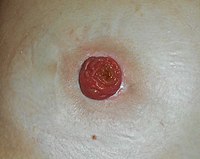
Photo from wikipedia
Following removal of hides and viscera during beef processing, carcasses are inspected for tissue adhesions that can affect meat quality or harbor bacteria. Carcasses with pleural or abdominal adhesions may… Click to show full abstract
Following removal of hides and viscera during beef processing, carcasses are inspected for tissue adhesions that can affect meat quality or harbor bacteria. Carcasses with pleural or abdominal adhesions may be diverted from the production line for manual excision, then returned to the line. No published data indicate whether adhesion excision is associated with bacterial contamination. Therefore, our objective was to determine the presence and concentration of generic Escherichia coli and non- E. coli coliforms from the internal and external surfaces of carcasses that were, or were not, diverted for adhesion excision. During nine processing days over a four-month period in a large commercial beef processing facility, 1,738 carcass sponge samples from 2,730 cm2 areas on both the internal and external surfaces of carcasses with and without tissue adhesions were collected. Coliforms and E. coli were cultured and enumerated using PetrifilmTM procedures, and data were analyzed with mixed models. Coliforms were present at higher concentrations than E. coli, and prevalence and mean log concentrations of both coliforms and E. coli were significantly higher for samples from the external than from the internal surfaces of carcasses. However, differences in prevalence and concentration of coliforms between external and internal surfaces varied significantly based on whether carcasses did or did not have adhesions excised. The difference was greatest for coliforms present on the external (2.06 log CFU/100 cm2) versus the internal (0.93 log CFU/100 cm2) carcass surfaces without adhesions, while the difference in concentrations from the external (1.80 log CFU/100 cm2) and internal (1.31 log CFU/100 cm2) surfaces of carcasses with adhesions was not as large. These results indicate that surveillance of carcass bacteria may be impacted by whether the external versus internal surfaces are sampled, and also on whether carcasses are diverted for excision of adhesions.
Journal Title: Journal of food protection
Year Published: 2022
Link to full text (if available)
Share on Social Media: Sign Up to like & get
recommendations!